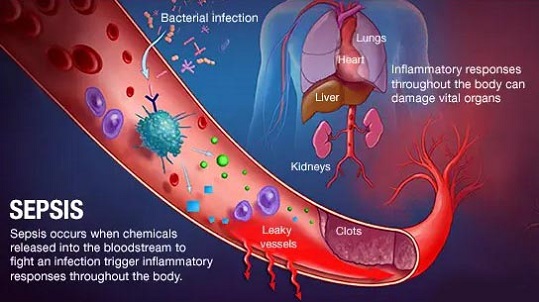Nikhil Prasad Fact checked by:Thailand Medical News Team Jul 29, 2024 8 months, 3 weeks, 6 days, 20 hours, 22 minutes ago
Medical News: Breakthrough in Sepsis Research
Sepsis is a critical condition where the body's response to infection causes damage to its own tissues and organs, leading to high morbidity and mortality rates. A new study by researchers at the University Hospital Regensburg-Germany has shed light on a novel aspect of sepsis and septic shock. This
Medical News report delves into their groundbreaking findings, offering a clearer understanding of the role of Bone Morphogenetic Protein 6 (BMP6) in these severe conditions.
 Reduced plasma BMP6 levels in sepsis - new insights into iron regulation
The Importance of BMP6
Reduced plasma BMP6 levels in sepsis - new insights into iron regulation
The Importance of BMP6
BMP6 is an essential regulator of hepcidin, a key protein that manages iron levels in the body by controlling its export from cells. Iron is crucial for various biological functions, including oxygen transport and DNA synthesis. During infections and inflammation, the body's iron regulation undergoes significant changes to limit iron availability to pathogens. This study is the first to measure BMP6 levels in patients with systemic inflammatory response syndrome (SIRS), sepsis, and septic shock.
Study Overview and Participants
The research involved a total of 155 patients categorized into three groups: 38 with SIRS, 39 with sepsis, and 78 with septic shock. Additionally, 43 healthy volunteers were included for comparison. The patients with septic shock included 23 individuals infected with SARS-CoV-2, the virus responsible for COVID-19. Blood samples were collected within 12 to 24 hours of admission to the intensive care unit, and BMP6 levels were measured using ELISA kits.
Key Findings of the Study
BMP6 Levels in Patient Groups:
-SIRS Patients: Patients with SIRS showed normal BMP6 levels, similar to those of healthy controls.
-Sepsis and Septic Shock Patients: These patients exhibited significantly reduced BMP6 levels compared to both SIRS patients and healthy controls. The median BMP6 concentration was 0 pg/mL in sepsis patients and 6 pg/mL in septic shock patients.
Correlation with Infection Types and Treatments:
-Infection Types: BMP6 levels were not influenced by the type of infection, whether bacterial or SARS-CoV-2.
-Ventilation and Dialysis: BMP6 levels did not vary significantly between ventilated and non-ventilated patients or between those undergoing dialysis and those who were not.
-Vasopressor Therapy: The need for vasopressor therapy did not affect BMP6 levels.
-Survivorship: There was no significant difference in BMP6 levels between survivors and non-survivors, indicating that BMP6 might not be a reliable predictor of mortality in sepsis patients.
&
lt;br />
Iron Metabolism Markers:
-Ferritin and Transferrin Levels: Iron, ferritin, and transferrin levels were measured in a significant portion of the patients. However, these did not correlate with BMP6 levels.
-Hepcidin Levels: Although elevated hepcidin levels are common in sepsis, they were not associated with BMP6 levels, suggesting that other regulatory mechanisms are involved in hepcidin elevation during sepsis.
-Plasma BMP6 Variability: There was a high degree of variability in plasma BMP6 levels among individuals, which was consistent with findings from other studies examining different populations. Despite the variability, the reduction in BMP6 levels in sepsis and septic shock patients was clear and statistically significant.
-Impact of Underlying Conditions: Conditions such as liver cirrhosis, pancreatitis, and cholangitis did not significantly alter BMP6 levels. This suggests that the observed reduction in BMP6 is directly related to sepsis and septic shock rather than other underlying health issues.
-Subgroup Analysis:
COVID-19 Patients: Among the patients with septic shock, those with COVID-19 had BMP6 levels comparable to those without SARS-CoV-2 infection. This indicates that the severity of the illness rather than the type of infection influences BMP6 levels.
-Dialysis and Mechanical Ventilation: Patients requiring dialysis or mechanical ventilation showed no significant difference in BMP6 levels compared to those not requiring these interventions. This was surprising as these treatments are typically associated with severe illness and inflammation.
Implications for Iron Regulation in Sepsis
The study provides important insights into how iron metabolism is regulated in sepsis:
-Hepcidin Regulation: Increased hepcidin levels during sepsis act to reduce iron export from cells, thereby lowering serum iron levels and limiting iron availability to pathogens. Despite reduced BMP6 levels, hepcidin levels remain elevated, suggesting that other pathways compensate for the decreased BMP6 activity.
-Iron and Inflammatory Markers: There was no correlation between BMP6 levels and common inflammatory markers such as C-reactive protein (CRP) and procalcitonin, further indicating that BMP6 does not play a direct role in the inflammatory response during sepsis.
Conclusion
This study highlights the complex nature of iron regulation in sepsis and septic shock. While BMP6 levels are reduced in these conditions, this reduction does not seem to drive the observed increase in hepcidin levels. The findings suggest that other pathways are involved in regulating hepcidin during severe infections, which could be potential targets for therapeutic interventions.
The study findings were published in the peer-reviewed journal: Biomedicines.
https://www.mdpi.com/2227-9059/12/8/1682
For the latest on
Sepsis, keep on logging to Thailand
Medical News.
Read Also:
https://www.thailandmedical.news/news/l-valine-from-gut-microbiota-helps-fight-sepsis
https://www.thailandmedical.news/news/unlocking-the-mystery-of-sepsis-new-biomarker-shows-promise
